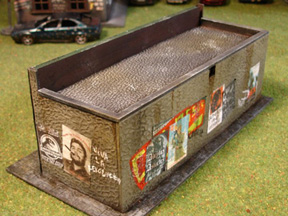|
|
| AN ONGOING NEWSLETTER | November 2006 |
by Arjen Pilon
|
When war is the normal state, weapons dealers make a killing. It is not surprising then, that weapon shops started popping up all over the city (but especially in the more restless areas) as hostility grew between different gangs. Most of these stores quickly discovered that the benefits of owning a weapon shop came with great risks as well, and that a customer who doesn't mind killing an enemy doesn't really care much about paying for merchandise either.
Supplying arms to several different gangs, Ruskin Arms falls under the former category. Owner Dave Ruskin is a gang veteran who knows the ropes and has protected his shop well. Of course this does not prevent gangs from trying to raid the place, but so far Dave has always come out on top. A voice-activated Avenger Robot in the corner doesn't hurt, either... People are always surprised! Building the model: Inspired by Gisby's terrain pieces I went on a search for plastic buildings. While they may be 'readily available' in the US, they are not in the Netherlands, and "O" scale which is quite suitable for 28mm games is equally unpopular here. Plasticville (and other) buildings can still be found on ebay though, and I bought a small collection of old buildings for not too much money.
One of these was the Plasticville supermarket. While its look was really quite inspiring, the building itself was far too small to offer the full It was still a very nice building, so I decided to replace the front wall and use the model as a weapons shop, keeping the supermarket front for a future project. A new storefront was cut from foamcore, with windows and doors in much the same place as the supermarket had. I glued wire mesh into the windows and the door was cut from artboard and glued inside (they don't open). The other three walls were glued together and mounted on a cardboard base which was scored with an old ballpoint pen to look like pavement. |
The roof was trimmed slightly to accommodate the new, thicker front, and was kept separate together with the front so I could easily access the inside for painting and modelling.
Painting the model: All pieces were sprayed black. The inside was then painted dark brown (which is easy to paint over black, and gives a nice wood look), the outside was drybrushed khaki, the roof and pavement were drybrushed grey and the front was painted green. After that it was time for the detail work. I raided my parts box for spare weapons, filed these smooth on one side (to mount them on the walls), and sprayed them black. With a metal drybrush and a Tamiya Smoke coat, they got a nice oily (new) look. Details were then picked out in black or brown and the weapons were glued to the walls. I made a simple construction of wire and cardboard to hold the two larger weapons. He was also given a nice backdrop (cardboard) with some info written on. I added a sign to the storefront, and it was glued to the rest of the building (the roof was kept loose to allow access to the inside). The whole building was then dirtied up with some drybrushes of leather brown, black and white, and with some washes of Vallejo Smoke and black. Finally some graffiti, newspapers and posters were added (both printed and cut from mail order catalogues). |

 The only weapon shops that remained were those that had a more than average concern for safety. This could either mean that the owner himself is a real tough nut to crack and the shop was protected from raids exceptionally well, or the shop was under protection of nearby gangs.
The only weapon shops that remained were those that had a more than average concern for safety. This could either mean that the owner himself is a real tough nut to crack and the shop was protected from raids exceptionally well, or the shop was under protection of nearby gangs.
 scope of grocery scenarios that came to mind.
scope of grocery scenarios that came to mind.

 Inside I built a counter out of artboard (which allows models to be placed on either side -just-), and since I was going to add an Avenger class robot to the store I built a small corner where it could be placed.
Inside I built a counter out of artboard (which allows models to be placed on either side -just-), and since I was going to add an Avenger class robot to the store I built a small corner where it could be placed.
 My avenger was undercoated white and painted in clean bone and dark red colours, with a gloss coat for a new look. The "head" was painted black, with a coat of Tamiya clear red to give it a bit of an 'infrared' look.
My avenger was undercoated white and painted in clean bone and dark red colours, with a gloss coat for a new look. The "head" was painted black, with a coat of Tamiya clear red to give it a bit of an 'infrared' look.